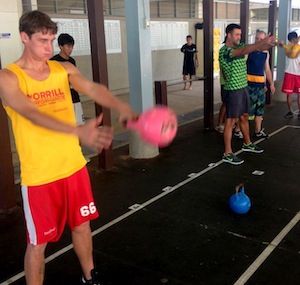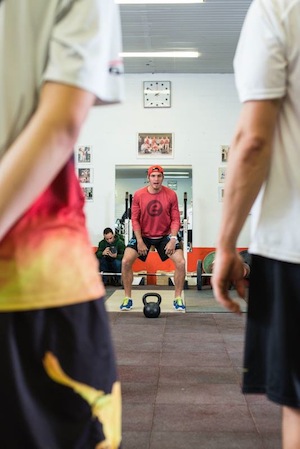
Standard Bodybuilding talk at the gym…
Bodybuilder 1: “Bro, do you even lift?”
Bodybuilder 2: “Yea I lift”
Bodybuilder 1: “Oh yea, well howmuchabench (all one word)”
Bodybuilder 2: “Oh, 2 plates bro, 2 plates for reps”
These bodybuilders are not athletes, and we should not mimic their training regiments. My vision for a standard conversation amongst us frisbee kids will go something more like this…
Ulti Player 1: “Bro, do you even lift?
Ulti Player 2: “I do, my friend! I’m getting nasty at cleans, actually. I cleaned 195 for a double this week on phase 6 of my program. These heavy doubles are really showing up on the field. I am getting D’s and skying people on repeat because my hips are so explosive,”
Ulti Player 1: “Thats awesome, I bet that’s really helping your vertical. I’ve been working on my kettlebell high rep explosive hip extension to train my power endurance. I want to be that work horse cutter that no one can keep up with. I got my 100 Rep Snatch Challenge (RSC) down to 4:00 minutes with the 20 KG bell and I am just torching defenders during long points”
Ulti Player 2: “Wow, I should try that. I feel super explosive but when I have to run a long point I get smoked.”
Ulti Player # 1 has developed power endurance while Ulti Player # 2 has developed power. The key is to train for both. Power endurance training will allow us to run fast for longer while raw power training will transfer to big explosive bids and skys. We should have an understanding of how to develop each quality. This series will give you an inside look into MP training methodologies and the strategies I use to develop these qualities with my athletes. This month will start with power endurance but look forward to March when we will discuss vertical power.
Developing Power Endurance
Power can be written as force multiplied by velocity (P=F x V) where force is equal to mass times acceleration and velocity is equal to distance divided by time.
Power (P) is represented by the watt (W); 1 watt is equal to 1 joule (1 Nm) persecond (J/s) In other words, how much force can you generate in a short amount of time. When you go up for a sky, you put all the force you can muster into the ground to propel yourself upward and get the disc faster than your opponent. Increasing power requires increasing both force and velocity. The capacity to generate force is increased via lifting heavy weights– you lift heavy weights fast to develop raw power (again, more on this next month!).
Power endurance is the ability to maintain force and velocity over extended periods of time. We need this quality to be able to maintain explosiveness when our legs are tired.
In the past we, have labeled drills like 150-yard shuttles and Goose Cones as power endurance training because they train us to run fast over extended periods of time. They are training endurance in some way, however they are not technically power endurance because they are missing the “force” part of the equation. The only way train the capacity to generate force is through loading (adding weight). We have to move weight (force) explosively (velocity) for high reps (endurance).
Does this mean we slap on a weighted vest and go run Goose Cones? No way. The answer and the future of ultimate training is high repetitions of Kettlebell swings & Kettlebell snatches.
Heavy Kettlebells (load=force), Kettlebell Swing & Snatch (explosive hip extension), high rep (endurance).
This sort of drill should be a staple in our off-season training:
100 Rep KB Snatch Challenge –
Boom. The hip extension pattern we see in the snatch is very to sprinting and will transfer to speed and power endurance on the field. This is where we make our money. Sprinting is repeat bouts of hip extension. During long points we may extend the hips a few hundred times. This KB snatch & swing pattern is lot like running. Running is repeat bouts of hip extension and so too is the KB swing /snatch. The major difference is that with the Kettlebell swing we are loading the hip extension because we have load (force) and velocity (swings motion) we are developing power.
To Building toward the 100-Rep Snatch Challenge:
You should all have your own kettlebells and you should be working toward the 100- snatch challenge. Did I say challenge? Yes! I challenge you to work toward the point that you can blast out 100 reps of the KB snatch non-stop with a heavy bell.
My friends, this is a journey. You cannot just start out snatching. You have to go through the progression. Here is it.
Phase 0 – Buy your own bell
You need your own kettlebells! They’re mandatory at Morrill Performance training camps. During the recent Team Germany 2015 MP Training Camp, I made all 50 athletes buy their own bells in order to gain entrance into the camp. Kettlebell training is the future my friends, so get on board early. Bros, start with a 16 – 20 kilogram bell, and ladies, start with a 12 – 16 kilogram bell. There is a link to great bells on sale here.
Phase 1 – Learn to hip hinge
The hip hinge is a fundamental athletic movement. It allows us to load the hamstrings and glutes in order to produce power. Groove it out.
Phase 2 -Learn to Swing: The Horizontal Pengellum
Swings are horizontal force production. This means the bell should move along a horizontal pendulum. We are not Crossfitters who swing the bell over their heads and we are not in a group fitness exercises class for middle aged women who squat the bell. Find and master your horizontal swing.
Phase 3 – One-arm Swings
Ultimate players are super asymmetrical. Grooving one-arm swings will promote symmetry and balance.

Morrill Performance Coach and DC Breeze athlete Alex Jacoski demoing the single arm swing on the current MP Asia tour.
Phase 4 – Snatch
The snatch forces us to be more aggressive with our swing pattern because the bell has to travel further. We also get some great overhead stability that transfers to a solid lay out position. We should start by snatching very light bells to groove the pattern. With time you should progress to swinging heavy bells.
Light Snatch:
Heavy Snatch:
Phase 4 – 100-Rep KB Snatch Challenge!
We should all be able to do this with great technique and without passing out. As we grow in our training age we will grow more efficient and will be able to use heavier bells.
Who is going to step up and show us that you accept the challenge? I know many of you are on this level. Melissa Gibbs? Glenn Poole? Teddy? Team Germany Bros? Betsy Calkins? Bryant Dean? Slumph? Goose? Russell? Cricket? Beau? Logan? Where you guys at? Film up your challenge upload it as MP 100 Rep Snatch Challenge and e-mail it to me at morrillperformance@gmail.com #leadthecharge #MPSnatchChallenge
Look forward to next month when we will take on vertical power.












Comments Policy: At Skyd, we value all legitimate contributions to the discussion of ultimate. However, please ensure your input is respectful. Hateful, slanderous, or disrespectful comments will be deleted. For grammatical, factual, and typographic errors, instead of leaving a comment, please e-mail our editors directly at editors [at] skydmagazine.com.